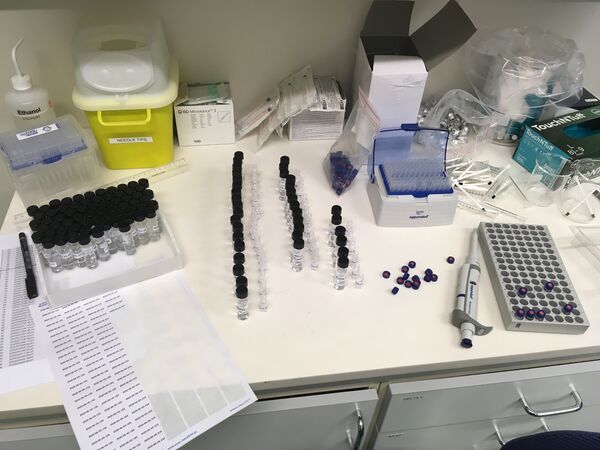Protocol for freshwater and saltwater stable isotope analysis on Picarro
General analysis checklist
Project preparations
- Customer contacts FARLAB member with a price inquiry, measurement capability.
- The customer fills out the registration form to provide contact and sample information.
- For water isotope analyses, HS or PTM approve the analysis request,
- Register project in FARLAB database (http://echo.geo.uib.no:8085),
- Prefill and rename sample list (File:water_isotopes_sample_list_template.xlsx.zip) and send it to the customer.
Sample handling
- Receive completed sample list and samples from customer
- Label samples with name of customer and FARLAB project ID, and place in fridge
- Include FARLAB IDs in sample list and check provided information
- Print out sample list.
- Print labels for small vials using Excel form: File:Mal merkelapper_xxxx-xx-HS.xlsx.zip
Preparing runs/batches
- Prepare sample containers and corresponding labelled 1.5 mL GC vials (see Fig. 1) such that chances for mix-up are minimised
- When samples do not need to be filtered, use 1000 uL pipette to transfer 1ml of water to the GC vial. Change pipette after each sample. For clean samples (snow) it can be acceptable to reuse tips after complete drying.
- When filtering of samples is required (groundwater, runoff, visible contaminations), use a syringe to pull liquid, place single-use Nylon filter on syringe tip, and transfer water to vial through the filter. Discard filter after use.
- Prepare standards from bottles in FARLAB fridge with 0.5 to 1.0 mL of standard. The range of standards depends on the samples. A too close proximity of the standards will give more uncertainty during calibration. The drift standard should be either DI2 (precipitation, runoff) or BERM (sea water analysis).
- Include one drift standard with the calibration standards, and one drift standard for every 7-9 samples processed during the run.
Running analysis for a batch
- Run sample analysis on Picarro HKDS2038, HKDS2039 with autosampler:
- Create sample_description_<FARLAB_ID>_run_xx.csv
- Log run details in instrument logfile on Picarro
- Test injection peaks 3x and adjust syringe volume
- Start run
- Monitor run from Remote Desktop/lab
- Check for humidity variations outside 15’000-25’000 ppmv
- Clean syringe, exhange septum if needed
- Recap/store or discard sample vials
- Update sample list
- Calibrate runs with FLIIMP
- Upload sample results to FARLAB database
- Repack and return/archive/discard samples
Overview: cal standards and drift standards, duplicates. Double peak, low memory option, fast option
Choosing the range of standards
Depending on the known or expected range of the samples, the calibration standards need to be chosen. The calibration standards should bracket the range of samples as close as possible. If the samples are processed in several batches from different sources (groundwater/snow/rain), the calibration standards may be adjusted for each run.
Typical combinations are:
- EVAP/VATS for mid-latitude precipitation samples
- DI/GSM1 or DI/VATS for snow
- EVAP/VATS for lake or stream water
DI should always be included as the long-term drift standard of the laboratory. The sequence of the standards should be such that the jump to the first sample is minimised. For example, when measuring snow samples, the sequence should be EVAP-DI-VATS-Sample1 etc.
Duplicate samples and standards
Memory is a challenge for all liquid measurements. Standards are measured with 12 injections, with 2 preceeding double-peak wet flushes, requiring in total 16 injections. Samples in contrast are commonly run with 6 effective injections, i.e. 10 injections with a double-peak wet flush. The isotope composition between the samples of one run typically varies less than the jump from the last standard and the first sample. Therefore, sample 1 is duplicated in the run, and discarded in the analysis.
The drift standard is introduced after 10 samples in the run sequence, and measured as if it were a sample. Since the drift standard is measured with 6 effective injections (10 actual), memory effects could again be introduced with the standard and the subsequent sample. Therefore, we duplicate the drift standard vial, and the subsequent sample vial. The resulting setup of the run is shown in Fig. X
Steps to start the run
- prepare samples
- prepare/label the vials with FARLAB ID (using excel form), number of samples (20) + 2 (duplicates) + 5 (standards) = 27
- pipette and filter the samples
- pipette standards (2 cal standards, and 3 vials of drift standards)
- fill to below neck level
- if cold, reopen unc
- prepare sample description
- log run details
- setup autosampler
- start coordinator
- start run
- during run
- as run is finished

